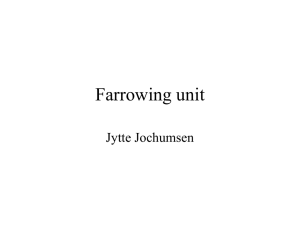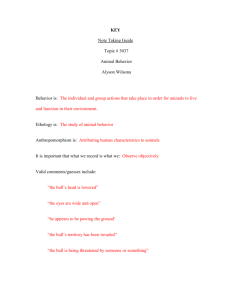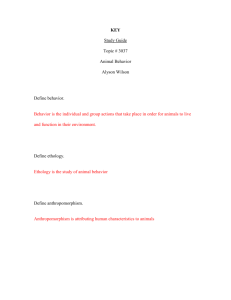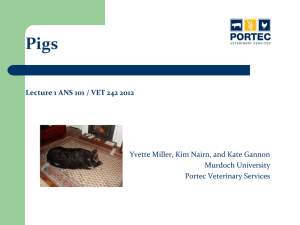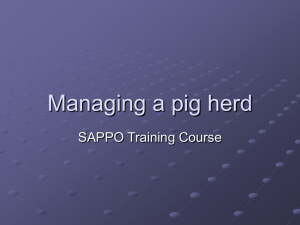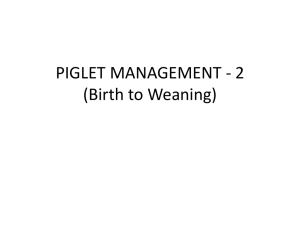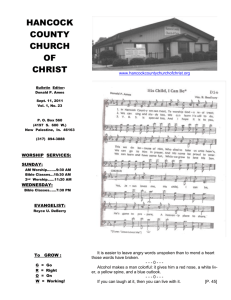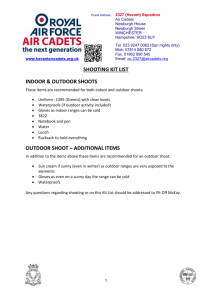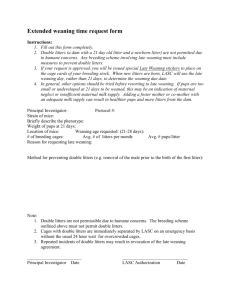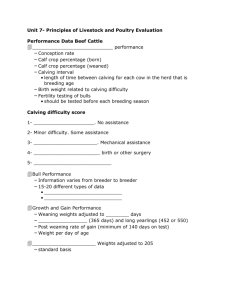Relationships between sow and piglet traits in organic production
advertisement
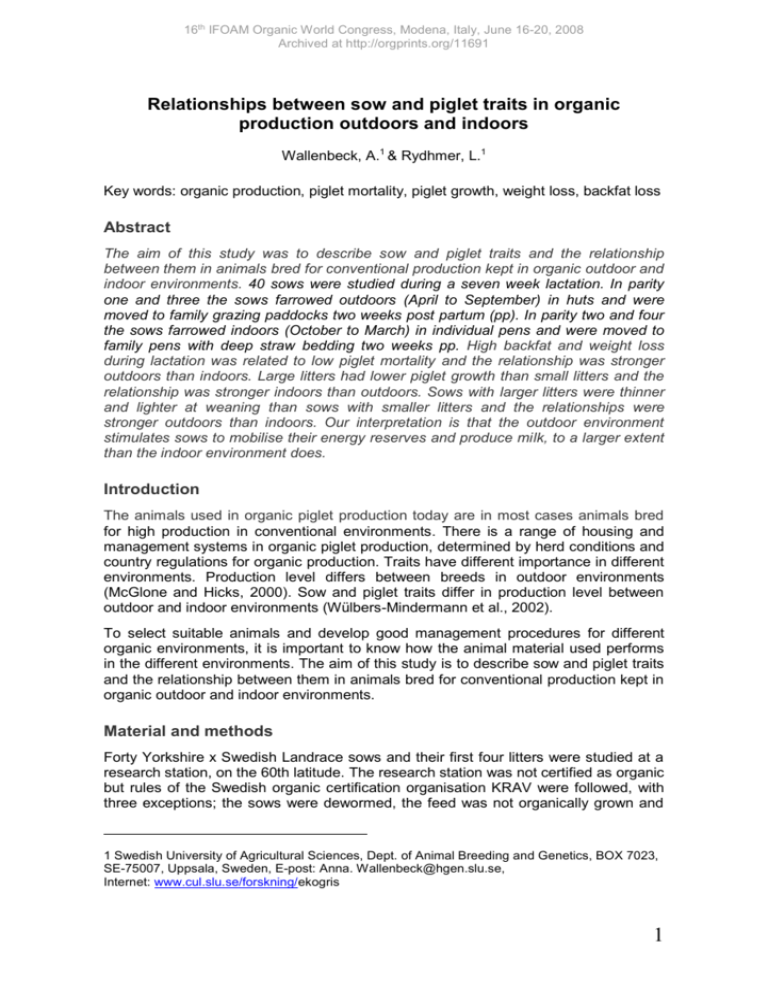
16th IFOAM Organic World Congress, Modena, Italy, June 16-20, 2008 Archived at http://orgprints.org/11691 Relationships between sow and piglet traits in organic production outdoors and indoors Wallenbeck, A.1 & Rydhmer, L.1 Key words: organic production, piglet mortality, piglet growth, weight loss, backfat loss Abstract The aim of this study was to describe sow and piglet traits and the relationship between them in animals bred for conventional production kept in organic outdoor and indoor environments. 40 sows were studied during a seven week lactation. In parity one and three the sows farrowed outdoors (April to September) in huts and were moved to family grazing paddocks two weeks post partum (pp). In parity two and four the sows farrowed indoors (October to March) in individual pens and were moved to family pens with deep straw bedding two weeks pp. High backfat and weight loss during lactation was related to low piglet mortality and the relationship was stronger outdoors than indoors. Large litters had lower piglet growth than small litters and the relationship was stronger indoors than outdoors. Sows with larger litters were thinner and lighter at weaning than sows with smaller litters and the relationships were stronger outdoors than indoors. Our interpretation is that the outdoor environment stimulates sows to mobilise their energy reserves and produce milk, to a larger extent than the indoor environment does. Introduction The animals used in organic piglet production today are in most cases animals bred for high production in conventional environments. There is a range of housing and management systems in organic piglet production, determined by herd conditions and country regulations for organic production. Traits have different importance in different environments. Production level differs between breeds in outdoor environments (McGlone and Hicks, 2000). Sow and piglet traits differ in production level between outdoor and indoor environments (Wülbers-Mindermann et al., 2002). To select suitable animals and develop good management procedures for different organic environments, it is important to know how the animal material used performs in the different environments. The aim of this study is to describe sow and piglet traits and the relationship between them in animals bred for conventional production kept in organic outdoor and indoor environments. Material and methods Forty Yorkshire x Swedish Landrace sows and their first four litters were studied at a research station, on the 60th latitude. The research station was not certified as organic but rules of the Swedish organic certification organisation KRAV were followed, with three exceptions; the sows were dewormed, the feed was not organically grown and 1 Swedish University of Agricultural Sciences, Dept. of Animal Breeding and Genetics, BOX 7023, SE-75007, Uppsala, Sweden, E-post: Anna. Wallenbeck@hgen.slu.se, Internet: www.cul.slu.se/forskning/ekogris 1 16th IFOAM Organic World Congress, Modena, Italy, June 16-20, 2008 Archived at http://orgprints.org/11691 the indoor housing did not have outdoor access. The sires of the litters were Hampshire boars. The sows were born and raised outdoors. Sows farrowing during winter and spring were kept indoors and sows farrowing summer and autumn were kept outdoors during pregnancy. In parity one and three the sows farrowed in huts (3.9 m2) in individual grazing paddocks (2500 m2). Two weeks post partum (pp) four sows and their piglets were moved to grazing paddocks (14000 m2) with one hut (13.0 m2) and one sun shed (11.0 m2). In parity two and four the sows farrowed indoors in conventional Swedish farrowing pens without crates (8.2 m2). Two weeks pp, four sows and their litters were moved to pens (55m2 – 114m2) with deep straw bedding in an uninsolated building. The sows were individually fed during pregnancy, in the farrowing paddocks and in the farrowing pens. In the family paddocks and the family pens the sows were fed ad lib from an automatic feeder, to which piglets had access. The feed followed a typical Swedish organic feed composition, with 12.2 MJ ME, 154.3 g crude protein, 122.6 g digestible protein and 7.5 g lysine per kg feed. The sows were weighed and measured for backfat (ultrasound) five days before expected farrowing as well as at two and seven weeks of lactation. The piglets were individually weighed at day four, two weeks and seven weeks pp. Piglet mortality was registered continuously from farrowing until weaning. During the first parity two sows were excluded the second week pp, one was treated for disease and the other was culled. Three sows were culled after weaning their first litter. During the second parity one sow was culled the second week and another during the fourth week pp. Two sows were culled after weaning their second litter and seven sows after their third litter. The statistical analyses were performed with the SAS package, version 9.1 (SAS institute, 2007). PROC GLM was used to estimate residual correlations. Number of live born piglets (15 classes), farrowing season (4 classes) and parity (4 classes) were included in the model. There was no significant interaction between season and parity. Number of live born piglets was excluded from the model when calculating correlations with litter size. For piglet weight day 4 and at weaning, age at weighing (days, 4 and 16 classes, respectively) were included in the model. For sow weight at farrowing and sow weight loss from farrowing to weaning, days from weighing to farrowing (mean 6 days std. 1.9) was included in the model (12 classes). Sow weight five days before expected farrowing was pre-corrected for estimated litter, placenta and amniotic fluid weight to better reflect the sow weight directly after farrowing. Results Least square means for production traits in different parities are given in Table 1. The negative correlation between litter size and piglet growth was stronger indoors than outdoors (Table 2). Sows with larger litters were lighter and thinner at weaning than sows with smaller litters and the relationships were stronger outdoor than indoor. Sows that lost much weight during lactation and were light and thin at weaning had lower mortality in their litters compared to fat and heavy sows, both indoor and outdoor. (Table 2). Piglet growth was not significantly correlated to sow weight or backfat loss. Outdoor litters with high mean piglet weight four days pp had lower mortality than litters with low piglet weight (Table 2). Large indoor litters had higher mortality than small litters (indoor r=0.30*, outdoor r=-0.10ns). 2 16th IFOAM Organic World Congress, Modena, Italy, June 16-20, 2008 Archived at http://orgprints.org/11691 Table 1: LS-means1 for production traits in parity 1 to 4 Litter size at d4 125 Parity 1 Outdoor N=37-40 8.8a % total mortality until weaning 107 30.1 23.3 31.2 20.5 Piglet mean weight at d4 (kg) 104 1.9a 2.4b 2.4b 2.3b DF Piglet growth, d4 - weaning (g/day) Sow weight at weaning (kg) 86 104 a 283 Parity 2 Indoor N=33-36 11.6b Parity 3 Outdoor N=31 10.5b Parity 4 Indoor N=25 12.8b b 393 409b c 273c 348 a 228 264 ab a a 196 b b Sow weight change (kg) 91 -22 -19 -32 -8b Sow backfat thickness at weaning (mm) 104 13.0 12.6 15.2 15.9 Sow backfat change (mm) 103 -6.9a -4.2ab -3.4bc -1.5c 1 The values marked with different superscripts on the same row differ from each other (p<0.05). The effect of parity and weighing days were included in the model. Table 2: Residual correlations between litter size, piglet mortality and piglet and sow traits *** = p<0.001, ** = 0.001<p<0.01, * = 0.01<p<0.05, † = 0.05<p <0.1. Number of piglets d4 Outdoor Parity 1 and 3 Indoor Parity 2 and 4 Piglet mean weight at d4 -0.53*** -0.72*** Piglet growth, d4 - weaning Sow weight at weaning Sow weight change Sow backfat thickness at weaning -0.45*** -0.35** -0.12 -0.47*** -0.72*** -0.03 -0.28† -0.40** Sow backfat change -0.20 -0.16 % piglets dead until weaning of live born Outdoor Indoor Parity 1 Parity and 3 2 and 4 -0.41** 0.30† * 0.39 0.04 0.43* 0.44** ** 0.44 0.38* ** 0.39 0.53*** ** 0.42 0.00 Discussion and conclusions During lactation, the sow has to handle the parent-offspring conflict; she has to prioritize between her own, her present litter's and her future litters' needs (Manning and Stamp-Dawkins, 1998). During the first parity the sow is not yet fully grown and need to prioritize energy also to her own growth (Noblet et al., 1998). In accordance to this we found that in first parity litter size, piglet mean weight, piglet growth and sow weight at weaning were significantly lower, and sow weight loss was significantly higher than in later parities (Table 1). Wülbers-Mindermann et al. (2002) found that sows with large litters lost more weight and fat during lactation than sows with small 3 16th IFOAM Organic World Congress, Modena, Italy, June 16-20, 2008 Archived at http://orgprints.org/11691 litters and that the relationship was stronger outdoor than indoor. In the present study we found no significant correlation between litter size and sow weight or backfat loss. Yet, we found that sows with large litters were lighter and thinner at weaning and the relationship was stronger outdoor than indoor. The outdoor environment seems to stimulate sows to mobilize energy reserves to produce milk to a larger extent than the indoor environment does and this seems to be important also for piglet survival. In our study, sows losing little weight and backfat during lactation had higher piglet mortality in their litters, both indoor and outdoor. Outdoor this relationship was also found for backfat change. These findings are in accordance to Grandinson et al. (2005). In order to have energy for the next parity, it is important that the sow has the ability to store and rebuild fat and weight (Whittemore, 1996). In this study, backfat loss during lactation decreased and backfat thickness at weaning increased with parity number (Table 1). Our interpretation of the estimated correlations from different environments is that an outdoor environment stimulates sows to mobilize their energy reserves and produce milk in favour of piglet growth, to a larger extent than the indoor environment does. It is important for organic pig producers to take these differences between environments into consideration in order to develop good sow management procedures for different organic environments. References Grandinson K., Rydhmer L., Strandberg E., Solares F.X. (2002): Genetic analysis of body condition in the sow during lactation, and its relation to piglet survival and growth. Anim. Sci. 80: 33-40. Manning A., Stamp-Dawkins M. (1998): Animal behaviour. Cambridge University Press, UK, 450 p. McGlone J.J., Hicks T.A. (2000): Farrowing hut design and sow genotype (Camborough-15 vs 25 % Meishan) effects on outdoor sow and litter productivity. J. Anim. Sci. 78: 2832-2835. Noblet J., Etienne M., Dourmad J.Y. (1998): Energetic efficiency of milk production. In Verstegen M.W.A., Moughan P.J., Schrama J.W. (eds.): The lactating sow. Wageningen Pers., Wageningen, p. 113-130. SAS Institute. Inc. (2007): SAS OnlineDoc®, Version 9. SAS Institute Inc., Cary, NC, USA. Whittemore C.T. (1996): Nutrition reproduction interactions in primiparous sows. Livest. Prod. Sci. 46: 65-83. Wülbers-Mindermann M., Algers B., Berg C., Lundeheim N., Sigvardsson N. (2002): Primiparous and multiparous maternal ability in sows in relation to indoor and outdoor farrowing systems. Livest. Prod. Sci. 73: 285-297. 4
